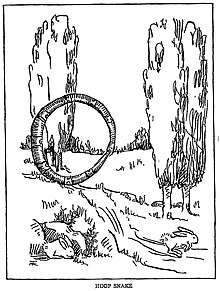Hoop snake
The Hoop Snake is a legendary creature of the United States, Canada, and Australia.[1] It appears in the Pecos Bill stories; although his description of hoop snakes is the one with which people are most familiar, stories of the creature predate those fictional tales considerably. Several sightings of the hoop snake have been alleged along the Minnesota-Wisconsin border in the St. Croix River valley, Wake County in North Carolina, and Kamloops, British Columbia.

In folklore
According to folklore, the distinguishing feature of a hoop snake is that it can grasp its tail in its jaws and roll after its prey like a wheel;[1][2] which is similar to the ouroboros in Greek mythology or the tsuchinoko in Japan. In one version of the myth, the snake straightens out at the last second, skewering its victim with its venomous tail. The only escape is to hide behind a tree, which receives the deadly blow instead and promptly dies from the poison.[3]
The hoop snake is mentioned in a letter from 1784 (published in Tour in the U.S.A., Vol. I, p. 263-65. London):[4]
As other serpents crawl upon their bellies, so can this; but he has another method of moving peculiar to his own species, which he always adopts when he is in eager pursuit of his prey; he throws himself into a circle, running rapidly around, advancing like a hoop, with his tail arising and pointed forward in the circle, by which he is always in the ready position of striking.
It is observed that they only make use of this method in attacking; for when they flee from their enemy they go upon their bellies, like other serpents.
From the above circumstance, peculiar to themselves, they have also derived the appellation of hoop snakes.
Sightings
Sightings are still occasionally reported, though the existence of the hoop snake has never been accepted by the scientific community. Naturalist Raymond Ditmars placed $10,000 in trust at a New York bank for the first person to provide evidence of a hoop snake.[5] Some have suggested it is a distorted description of the sidewinder of the American Southwest, or of mud snakes, which will occasionally lie in a loose hoop shape.[3][6] The hoop snake possibly is an embellishment of actual instances of snakes swallowing their own tails, mistaking them for prey.[7]
See also
References
- Graham Seal (2009). Great Australian Stories: Legends, Yarns and Tall Tales. Allen & Unwin. p. 138. ISBN 978-1-74175-847-4.
- S. E. Schlosser (2006-08-07). "Hoop snake". American Folklore. Archived from the original on 13 August 2006. Retrieved 14 September 2006.
- "Eastern Mud Snake". Florida Museum of Natural History. Retrieved 14 September 2006.
- Karl Patterson Schmidt. "The Hoop Snake Story". Archived from the original on 29 June 2006. Retrieved 14 September 2006.
- Ford, Joe, Haunts to Hookers., from the chapter "Snakes: Fact or Fable", pgs. 80-84.
- "Modern Myths About Snakes". The Biology Department at Davidson College. Retrieved 14 September 2006.
- Mehra, Rohan. "Autocannibalism is when you eat bits of your own body". www.bbc.com. Retrieved 2019-04-10.